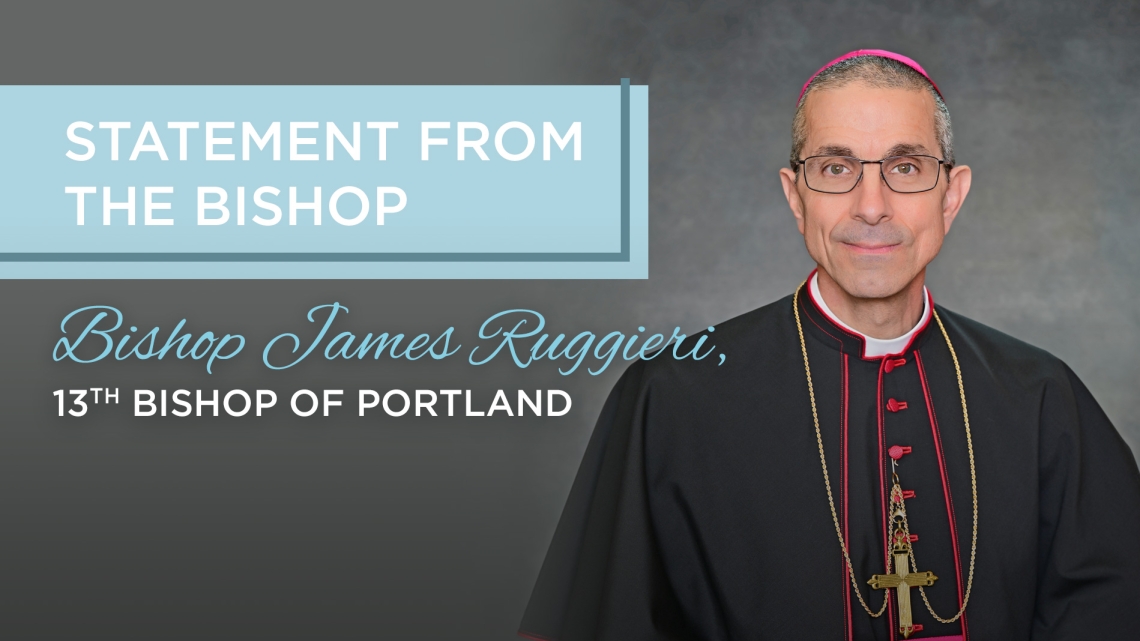A follow-up letter from Bishop Ruggieri regarding St. Dominic Academy

Dear St. Dominic Academy Families,
I am writing today to provide further clarity and details around my decision to close the high school division of St. Dominic Academy in Auburn after this academic year. I would never take such a decision lightly. But, after much prayer and analysis of past, present and future finances and enrollment, it was, unfortunately, the only choice.
I am very aware of the difficult consequences of this decision. Students who were expecting to continue or begin their high school experience at St. Dominic Academy will not have this opportunity. Teachers and staff of the high school will be unemployed. Alumni will no longer have their alma mater.
These are all painful realities that have caused anger and sadness in these past two weeks, which is not surprising given that the St. Dominic Academy high school has been part of the fabric of the Lewiston-Auburn communities and beyond since 1941.
Please allow me to share some of the important information that ultimately led to this decision, focusing on three key areas that I hope will lead to greater understanding.
- Cash Flow & Finances
- Demographics & Enrollment
- Fundraising & Development
This letter is lengthy; it is important to be detailed and to share the extensive investment made to keep St. Dominic Academy viable as a high school.
Cash Flow & Finances
Current Year: 2024-2025
Cash flow to fund Saint Dominic Academy’s operations this year is a daunting challenge. By way of example, beginning last week the diocese began loaning funds to the school because it did not have the money to make payroll for teachers and staff and to pay vendors. This on-going cash flow issue is a result of a dependence on future tuition payments. Currently, tuition and other payments that will be received after March 31, 2025 for the current school year are estimated to be $400,000 while payroll alone for the remainder of the year will be $1,000,000.
The total loan amount from the diocese to St. Dominic Academy by the end of August for the current school year will be an estimated $1.2 million – this breaks down to $900,000 in cash assistance in the form of loans to meet payroll and vendor bills and $300,000 for health insurance, non-teacher pensions and property insurance bills.
To put this in perspective, to cover past bills and the cash deficit for this school year, all St. Dominic Academy families would need to pay an additional $3,000 per student by year-end, as well as any outstanding tuition currently owed.
Previous Diocesan Assistance
These financial challenges are not new. As I shared in my letter on March 28, St. Dominic Academy has had an operating deficit every year since 2020. The total operating deficit for 2020-2025 is forecasted to be $2.5 million by the end of the school year.
The diocese has regularly covered cash deficits to maintain the student experience and to pay employees. The diocese can no longer continue to do this without borrowing money from its Diocesan Savings and Loan program. Doing this would have a dramatic impact on other ministries and programs.
In addition to the current year figures outlined in the section above, there are outstanding loans totaling $819,900 and bills covered by the diocese of $223,560, some of which predate 2020.
Demographics & Enrollment
A significant problem lies in the number of students in the high school – or more accurately, the lack of them. Today, there are 137 students enrolled in the high school division of St. Dominic Academy. The average number of students since 2020 is 132, which contributes to debt and cash flow problems due to far fewer tuition dollars coming in each year. Looking ahead, the picture is no brighter.
As part of an effort to examine how we could make St. Dominic Academy sustainable and vibrant, the diocese commissioned and funded an independent study conducted by Meitler, a recognized leader in strategic planning for Catholic organizations. The study revealed some sobering census demographics.
- Most St. Dominic Academy students reside in either Lewiston or Auburn. Between 2023 and 2028, the number of children aged 10 to 14 in these communities is projected to decline by approximately 2.7%.
- In 2028, the projected population of children aged 10 to 14 in Lewiston and Auburn will be 3,611 – or 100 fewer than in 2023.
This is a problem because this is the age group that St. Dominic Academy would be recruiting to attend the high school. If that population decreases as projected, expecting high school classes to increase dramatically to help fund future operating costs and the school’s share of debt is unrealistic.
The Meitler study did project an increase in enrollment for the high school; however, not by enough to change our dynamic. We arguably need to double our current high school student population, and that estimate is based on full-pay students.
The second component of that solution is just as critical as the first, and again, is structurally problematic. The majority of St. Dominic Academy families today do not pay full tuition, for a variety of reasons. Consider this:
- In the 2022-2023 school year, 60% of students received some degree of financial assistance to attend, according to the Meitler analysis.
- If there is not a significant rise in the number of students, one way to bridge the gap between expenses and revenue is to raise tuition, currently at $14,450. If expenses remain flat or show only a modest increase, there will have to be a significant increase in tuition to meet ordinary expenses.
- It is unrealistic to presume a far greater percentage of our families will be able to pay full tuition. According to the United States Census, the median income of Lewiston is approximately $56,556 and in Auburn is $66,552. Setting significantly higher tuition for families in our communities is unrealistic and unfair. The hope would be to offset this with fundraising.
Fundraising & Development
A feasible way to encourage local families to send their high school students to St. Dominic Academy is to increase financial assistance beyond what is already allocated. Funds for financial assistance are accumulated in varied ways including endowments, diocesan aid, and one-time gifts.
Private schools like St. Dominic Academy often depend on robust development programs to generate these funds. Unfortunately, the development income at St. Dominic Academy has not yielded the necessary results.
- Meitler, in its study, recommended that development income should be at or above 10% of total school revenue as a benchmark.
- In 2020-2021, development income dropped to 5% of total school revenue; in 2021-22, it dropped to 3.5% and continued to dip further the following year.
- The average amount raised by the development office of St. Dominic Academy since 2020-2021, except for this year, is $161,887, which is far below the desired benchmark of 10% of total revenue.
- This year, with considerable effort by school leadership, development revenue for St. Dominic Academy is currently $239,371. While encouraging, past difficulties have already made an impact.
- The total projected income for this year is approximately $5,400,000, so with a quarter to go, development accounts for about 4.4% of total revenue.
Obviously, various factors contribute to a school’s ability to raise money from donors. One significant factor for success is having an active and engaged alumni association. St. Dominic Academy has a significant and proud history and a large pool of alumni dating back to its early decades.
That said, the St. Dominic Academy Alumni Association went dormant after 1990 and only recently have efforts been made to build and cultivate those relationships again. This will take time and the need is urgent. Currently, donors are few, average gifts have been modest, and the school has relied upon only a handful of generous donors to deliver much-needed financial support.
Moving Forward
St. Dominic Academy has had a profound impact on the lives of its high school students and their families for decades. Its closure hurts in so many profound ways. My decision was not a subjective choice, but rather a result of objective reality.
There is an effort underway by a group of concerned parents, community members and current school employees to keep the high school open as a private, non-profit Catholic school. I have reviewed the proposal, which includes consolidating the elementary, middle and high schools on the Auburn campus, and have responded. The diocese is committed to sustaining a vibrant pre-k to grade 8 program in Lewiston. I cannot support moving pre-k to grade 5 to the Auburn campus, nor keeping grades 6-8 at that location. I do not believe it is in the best long-term interest of the elementary and middle schools.
I will not inhibit the group’s efforts related to establishing this high school and have asked for an updated proposal. As this letter conveys, there is an extremely difficult fact set to overcome to achieve this goal. We will all learn where those efforts lead, hopefully in short order. But it is critical for proponents to understand that the diocese will not finance, staff, nor operate the high school after the end of this school year. The new entity, as a renter at the Auburn campus, would assume all those obligations as well as all fundraising.
As previously communicated, on Thursday, April 10 at 6 p.m. on the Auburn campus, I, along with other representatives from the diocese, will host a session for the families of current grade 8 to grade 12 students to answer questions and to provide support for those seeking information on transitioning to a new high school. On Monday, April 14 at 6 p.m., a session will be held for rising pre-k to grade 8 families at the Holy Cross campus in Lewiston. It is my sincere hope that these sessions will be helpful, productive and a step forward.
Sincerely,
Bishop James T. Ruggieri









